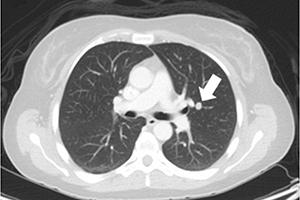Role of segmentectomy for pulmonary metastases
Abstract
Pulmonary metastasectomy has not been proven by randomized trials to be more effective than non-operative management, but currently has a well-accepted role for certain primary cancers, in particular colorectal cancer and sarcoma. One of the principal tenets for pulmonary metastasectomy is that all lesions are resected. A major technical difference compared to surgical management of primary lung cancer is that management of metastatic disease frequently requires the resection of multiple and possibly bilateral lesions. In addition, surgeons and patients must often consider repeat surgery for management of metachronous lesions that develop some time after a previous resection, given the nature of metastatic cancer. Therefore, surgeons must ensure complete resection of lesions with negative margins but also must be cognizant of minimizing resection of functional lung tissue as much as possible, in order to ensure that both current and future lesions can be resected while leaving patients with adequate pulmonary function. Segmentectomy is generally infrequently utilized for pulmonary metastasectomy, but has a role for lesions for which a wedge resection is technically not possible but a lobectomy is not required. Segmentectomy can be an important tool in achieving the dual goals of complete resection and impacting pulmonary function as little as possible. Using minimally invasive techniques with thoracoscopy to perform segmentectomy is associated with less short-term morbidity than thoracotomy. Although the use of minimally invasive techniques limits manual palpation and therefore potential resection of small lesions not identified by pre-resection imaging, the current literature does not suggest that these procedures should be done via thoracotomy.
Cover






